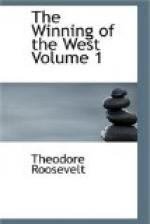The chief tribes, however, were well known and occupied tolerably definite locations. The Delawares or Leni-Lenappe, dwelt farthest east, lying northwest of the upper Ohio, their lands adjoining those of the Senecas, the largest and most westernmost of the Six Nations. The Iroquois had been their most relentless foes and oppressors in time gone by; but on the eve of the Revolution all the border tribes were forgetting their past differences and were drawing together to make a stand against the common foe. Thus it came about that parties of young Seneca braves fought with the Delawares in all their wars against us.
Westward of the Delawares lay the Shawnee villages, along the Scioto and on the Pickaway plains; but it must be remembered that the Shawnees, Delawares, and Wyandots were closely united and their villages were often mixed in together. Still farther to the west, the Miamis or Twigtees lived between the Miami and the Wabash, together with other associated tribes, the Piankeshaws and the Weas or Ouatinous. Farther still, around the French villages, dwelt those scattered survivors of the Illinois who had escaped the dire fate which befell their fellow-tribesmen because they murdered Pontiac. Northward of this scanty people lived the Sacs and Foxes, and around the upper Great Lakes the numerous and powerful Pottawattamies, Ottawas, and Chippewas; fierce and treacherous warriors, who did not till the soil, and were hunters and fishers only, more savage even than the tribes that lay southeast of them.[1] In the works of the early travellers we read the names of many other Indian nations; but whether these were indeed separate peoples, or branches of some of those already mentioned, or whether the different travellers spelled the Indian names in widely different ways, we cannot say. All that is certain is that there were many tribes and sub-tribes, who roamed and warred and hunted over the fair lands now forming the heart of our mighty nation, that to some of these tribes the whites gave names and to some they did not, and that the named and the nameless alike were swept down to the same inevitable doom.
Moreover, there were bands of renegades or discontented Indians, who for some cause had severed their tribal connections. Two of the most prominent of these bands were the Cherokees and Mingos, both being noted for their predatory and murderous nature and their incessant raids on the frontier settlers. The Cherokees were fugitives from the rest of their nation, who had fled north, beyond the Ohio, and dwelt in the land shared by the Delawares and Shawnees, drawing to themselves many of the lawless young warriors, not only of these tribes, but of the others still farther off. The Mingos were likewise a mongrel banditti, made up of outlaws and wild spirits from among the Wyandots and Miamis, as well as from the Iroquois and the Munceys (a sub-tribe of the Delawares).




